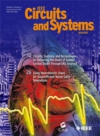2013
- Ryo Takahashi and Ken Umeno, "Performance Evaluation of CDMA Using Chaotic Spreading Sequence with Constant Power in Indoor Power Line Fading Channels", IEICE Transactions on Fundamentals of Electronics, Communications and Computer Sciences. (2014, in press). NEW
- K. Umeno and M. H. Kao, "Chaos Theory as the answer to limited spectrum?", ITU News, No.10, 2013.

 Chen-An Yang, Kung Yao, Ken Umeno and Ezio Biglieri, "Using Deterministic Chaos for Superefficient Monte Carlo Simulations", IEEE Circuits and Systems Magazine, 13 (2013), pp.26 - 35.
Chen-An Yang, Kung Yao, Ken Umeno and Ezio Biglieri, "Using Deterministic Chaos for Superefficient Monte Carlo Simulations", IEEE Circuits and Systems Magazine, 13 (2013), pp.26 - 35.- Shun Ogawa, Spectral and formal stability criteria of spatially inhomogeneous solutions to the Vlasov equation for the Hamiltonian mean-field model, Phys. Rev. E 87, 062107 (2013), arXiv:1301.1130
- Ken Umeno, Statistical Mechanics of Information, Mathematical sciences (in Japanese) No. 600 (2013), pp. 35-41
- K. Umeno and A.-H. Sato, "Chaotic Method for Generating q-Gaussian Random Variables", IEEE Transactions on Information Theory, 59 (2013), pp.3199 - 3209.
*Master course students write Master Theses obligatorily.
We show the titles and abstracts of master course students belonging to our laboratory during the last few years.
March 2014 |
|
|---|---|
March 2013 |
|
March 2012 |
|
March 2011 |
|
March 2010 |
|
March 2009 |
|
March 2008 |
|
March 2007 |
March 2014
Tomoki ARIIStudy on CDMA Systems with Primitive Root CodesAbstract : | ||
Satoshi IRIEStudy on the high-precision Monte-Carlo computation using random numbers with nonuniform densityAbstract : | ||
Tomohiro KUSERobustness of interdependent networks with degree-correlated inter-connectionsAbstract : | ||
March 2013
Masato IWATATitleAbstract : | ||
Ryosuke OZAKITitleAbstract : | ||
Hiroshi KAJIKAWALinear Regression Analysis of Foreign Exchanges with a Method of Segmenting Time Series Based on the Likelihood-Ratio TestAbstract : | ||
Yuzo MORITAAnalysis of Foreign Exchange Rates Based on Parametric Risk Assessment Procedures with q-Gaussian and Pearson type IV DistributionsAbstract : | ||
Genta YOSHIMURACapacity-Approaching LDPC Codes Constructed from Extended ProtographsAbstract : | ||
March 2012
Kazuo IKEDAOpinion propagation using partisan voter models on several networksAbstract : | ||
Minoru NODAJapanese hotel statistics in terms of regional room capacitiesAbstract : | ||
Atsushi MORIOKAOptimization of routing strategies for data transfer in peer-to-peer networksAbstract : | ||
March 2011
Keigo NAGATAAnalysis of image encryption schemes using chaotic mapsAbstract : | ||
Takeshi NAKAMOTOEstimating the tail index of distributions: Case study on the foreign exchange marketAbstract : | ||
Kenta NISHIOKALog returns of stock values and q-Gaussian distributions: Application to the risk-assessmentAbstract : | ||
March 2010
Takuya OHTANISequential associative memories on complex networksAbstract : | ||
Atsushi SUNAGAWAActive random walkers: a simple model fro catalyst dynamicsAbstract : | ||
March 2009
Makoto KIMIZUKAProperties of coupled double well systems with delay and noiseAbstract : | ||
Takeo KONDOSignal response in scale-free network of bistable unitsAbstract : | ||
Maiko NISHIMURAScaling analysis on quotation activities in the foreign exchange market: Empirical investigation and stochastic modelingAbstract : | ||
Takashi MARUYAMAVirus Spreading Models on Peer-to-Peer NetworkAbstract : | ||
March 2008
Shinpei IWAMAEffects of time delay on nonlinear stochastic systemsAbstract : | ||
Taiki KAWAMOTOEfficient packet routing strategy in complex networksAbstract : | ||
Hiroshi SAKAIDiscrimination and Cluster methods for multi-dimensional time series of the Foreign Exchange Market based on Spectral DistancesAbstract : | ||
Mitsuki TARAOInformation Flow and Causality in Coupled SystemsAbstract : | ||
March 2007
Motoya KOZAKIApplication of the Beck model to stock markets: Value-at-Risk and portfolio risk assessmentAbstract : | ||
Kohei SHINTANIEmpirical analysis and numerical simulation of foreign exchange market dynamicsAbstract : | ||
Boyong JoeSelf-tuning of activation energy in a two-state systemAbstract : | ||
Yuki NAGANUMAPacket routing strategy using neural networks on complex networksAbstract : | ||
Yuma MATSUDASynchronization of a randomly coupled map model for neural networksAbstract : | ||


